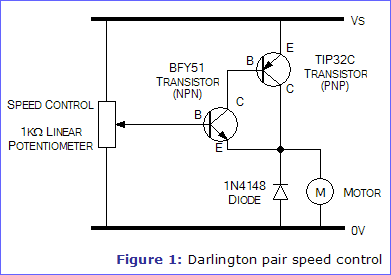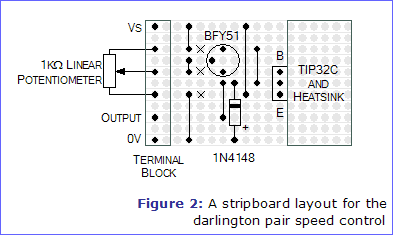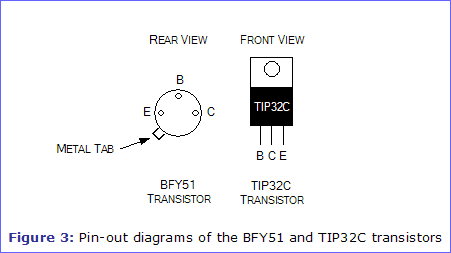|
Another Darlington Pair Speed Control By Howard Lloyd |
| |
||||
| |
Control your Meccano models (or anything else) from your Windows PC!
Take a look at my new MECControl project at meccontrol.com
One disadvantage of the simple Darlington pair motor speed control discussed in the previous article is that about 0.7V is lost in each transistor, so the maximum voltage that can ever be applied to the motor is Vs - 1.4V. The circuit shown in figure 1 partially solves this problem by reducing the voltage loss to 0.7V. It is still a Darlington pair configuration, but this time the second transistor is of a type known as 'PNP'. The first transistor is an 'NPN' type of transistor.
| Related Articles | Darlington Pair Speed Control |

To increase the range of the potentiometer you may want to place a low value resistor (try 470Ω) between the lower end of the potentiometer and 0V. This should start the motor turning slowly as soon a the potentiometer shaft is turned.
Building the Circuit
A stripboard layout for this circuit is given in figure 2. The layout includes space for an optional 6-way screw terminal block to make connecting up the circuit easier.

The power supply for this circuit should preferably be un-smoothed (i.e. directly from the power supply rectifier). This helps prevent the motor 'sticking' at low speeds. With the TIP32C transistor given, the maximum power supply voltage may be 60V and the maximum motor current consumption may be 3A.
Pin-out diagrams of the two transistors used in this circuit are given in figure 3. The TIP32C transistor will get hot in use because the high current supplying the motor flows through it. You should therefore fit a heat sink to it to dissipate the heat - a suggested heat sink is given in the Shopping List, or you could make one out of Meccano! Space is provided in the stripboard layout for a heat sink, but the positions and sizes of the holes are not shown for they will depend on the nature of the heat sink you choose.

Construction
- Cut a piece of stripboard to 11 tracks x 18 columns + extra columns if the heat sink you use is larger.
- If you wish to fit a 6-way screw terminal block, use a 1.5mm diameter drill bit to enlarge the six holes in the stripboard shown within the left-hand rectangle. Somewhere within the right-hand rectangle, you will also need to drill holes of the appropriate size and in the appropriate position for your chosen heat sink.
- Fit the 6 wire links.
- Fit the 1N4148 diode, taking care to place the diode the correct way around.
- Fit the 6-way screw terminal block.
- Fit the BFY51 transistor. Place a crocodile clip around each leg of the transistor before soldering. This 'heat shunt' will prevent the heat from your soldering iron damaging the transistor. Try to keep the soldering time to a minimum for this component.
- Fit your chosen heat sink - this must be done before you fit the TIP32C transistor to it!
- Fit the TIP32C transistor with the B leg at the top, such that the legend on it points to the left. Bolt the TIP32C to the heat sink.
- Cut the copper tracks where an X is shown. If the heat sink shorts out any of the tracks, cut them at an appropriate place to avoid this.
- Connect a potentiometer to the circuit as shown. The 'wiper' terminal on a potentiometer (shown in figure 2 by the line with the arrow) is normally the centre terminal. The other two terminals may be connected either way around.
- Connect a motor between the Output and 0V.
- Connect up a power power supply and test the circuit.
 Shopping List
Shopping List
The list below includes all the parts required to build the Darlington pair circuit on stripboard as shown in figure 2. The 470 Ohm resistor is optional.
Part
DescriptionQuantity
RequiredRapid
CodeUnit
PriceTotal
Price1kΩ 0.2W Miniature Linear Potentiometer 1 65-0705 £1.67 £1.67 1N4148 Signal Diode 1 47-3416 £0.02 £0.02 38mm Heatsink for TO220 Style Transistor Cases 1 36-0226 £5.47 £5.47 3-way PCB Mounting Terminal Block 2 21-0473 £0.29 £0.58 470Ω 0.25W Metal Film Resistor 1 62-3442 £2.66
(per pack of 100)£2.66 BFY51 Medium Power NPN Transistor 1 81-0122 £0.91 £0.91 Stripboard SRBP (36 rows x 50 columns) 1 34-0412 £3.13 £3.13 TIP32C High Power PNP Transistor 1 81-0822 £0.70 £0.70 Grand Total £15.14
Order the above items from Rapid Electronics via our Circuits Shop and help support the Electronics in Meccano website, without affecting the price you pay! Just click on an item for information about it and/or to add it to your Rapid order.
Orders can also be placed by telephoning Rapid on 01206 751 166 or visiting their website at www.rapidonline.com. Prices quoted include VAT at 20%.
|
|
| Article Information |
Top of Page | Homepage | About | Search | Topics | Features | Circuits Shop | yourEiM |
© 1998 - 2025 Tim Surtell |